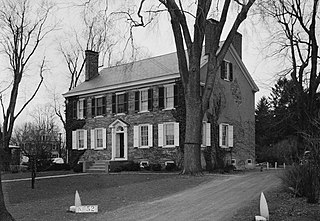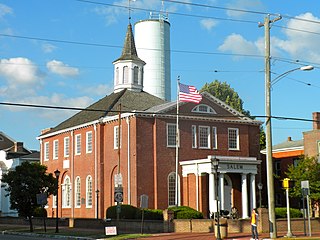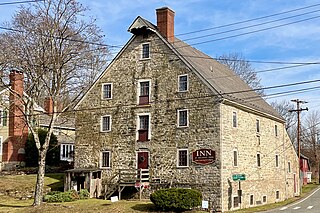
Johnsonburg is an unincorporated community and census-designated place (CDP) located within Frelinghuysen Township in Warren County, in the U.S. state of New Jersey, that was created as part of the 2010 United States Census. As of the 2020 Census, the CDP's population was 381, up from 101 in the 2010 Census.

The Lawrence Township Historic District is a 550-acre (220 ha) historic district encompassing the community of Lawrenceville in Lawrence Township, Mercer County, New Jersey, United States. It was added to the National Register of Historic Places on September 14, 1972 for its significance in architecture, landscape architecture, literature, military history, and transportation. The district includes 45 contributing buildings.

Mays Landing Presbyterian Church is a historic church built in 1841 and located at Main Street and Cape May Avenue in the Mays Landing section of Hamilton Township in Atlantic County, New Jersey, United States. It was documented by the Historic American Buildings Survey (HABS) in 1938 and was added to the National Register of Historic Places on April 20, 1982, for its significance in architecture and religion. The church was added as a contributing property to the Mays Landing Historic District in 1990.

Saint Peter's-By-The-Sea Episcopal Church, known locally as The Gingerbread Church, is a historic church located at the junction of Ocean Avenue and Lake Drive in Cape May Point, Cape May County, New Jersey, United States. It was documented by the Historic American Buildings Survey in 1992. It was later added to the National Register of Historic Places on August 3, 1995 for its significance in Stick/Eastlake architecture and also community planning and development.

Trinity & St. Philip's Cathedral is a historic church located at Broad and Rector Streets in Military Park in the city of Newark in Essex County, New Jersey, United States. It is the seat of the Episcopal Diocese of Newark. The church building was added to the National Register of Historic Places on November 3, 1972, for its significance in architecture and religion. It was added as a contributing property to the Military Park Commons Historic District on June 18, 2004.

Moravian Church is a historic church building located on Swedesboro-Sharptown Road in the Oliphant's Mill section of Woolwich Township, Gloucester County, New Jersey. The church was dedicated in 1789 and documented by the Historic American Buildings Survey (HABS) in 1938. It was added to the National Register of Historic Places on April 3, 1973, for its significance in architecture and religion. The property is currently under the stewardship of the Gloucester County Historical Society.

St. Thomas Episcopal Church is a historic church located at the southeast corner of Main and Focer streets in the borough of Glassboro in Gloucester County, New Jersey. It was built in 1846 and documented by the Historic American Buildings Survey (HABS) in 1937, with an addendum in 1984. It added to the National Register of Historic Places on March 3, 1975, for its significance in architecture.

Trinity Church, also known as Old Swedes' Church, is a historic church on the northwest corner of Church Street and King's Highway in Swedesboro in Gloucester County, New Jersey, U.S.

The James Whitall Jr. House is located at 100 Grove Avenue in the borough of National Park, Gloucester County, New Jersey. The house was built in 1766 and documented by the Historic American Buildings Survey (HABS) in 1937. It was added to the National Register of Historic Places on February 6, 1973, for its significance in architecture.

The Fairview Schoolhouse is located east of Columbia in the Fairview Cemetery along Dean Road in Knowlton Township in Warren County, New Jersey, United States. It was built in 1835 and documented by the Historic American Buildings Survey (HABS) in 1937. The schoolhouse was added to the National Register of Historic Places on August 12, 1977, for its significance in architecture and education. It is now used by the Fairview Cemetery Association.

The Market Street Historic District is a 166-acre (67 ha) historic district located along Market Street in the downtown area of the city of Salem in Salem County, New Jersey, United States. It was added to the National Register of Historic Places on April 10, 1975, for its significance in architecture, art, commerce, industry, military history, religion, social history, and transportation. The district includes 44 contributing buildings.

The Millstone Historic District is a historic district located in Millstone, Somerset County, New Jersey. The district was added to the National Register of Historic Places on September 13, 1976 for its significance in education, military history, settlement, and transportation. It includes 58 contributing buildings.

The Oldwick Historic District is a 170-acre (69 ha) national historic district located along County Route 517, Church, King, James, Joliet and William streets in the Oldwick section of Tewksbury Township in Hunterdon County, New Jersey. The district was added to the National Register of Historic Places on November 14, 1988, for its significance in architecture, commerce, and industry. It includes 127 contributing buildings, 12 contributing structures, and one contributing site. The Kline Farmhouse, listed individually in 1984, also contributes to the district. Many of the buildings were documented by the Historic American Buildings Survey.

Millbrook, also known as Millbrook Village, is an unincorporated community located along Old Mine Road within Hardwick Township, formerly Pahaquarry Township, in Warren County, in the U.S. state of New Jersey. It is named after the Mill Brook, now known as Van Campens Mill Brook, a tributary of the Delaware River. The area is now part of the Delaware Water Gap National Recreation Area.

The Middlesex Avenue–Woodwild Park Historic District is a historic district located in the borough of Metuchen in Middlesex County, New Jersey. The district was added to the National Register of Historic Places on July 31, 2017. It includes 197 contributing buildings, five contributing objects, and one contributing site.

The Old Mine Road Historic District is a 687-acre (278 ha) historic district located along Old Mine Road in Sussex County and Warren County, New Jersey. It is part of the Delaware Water Gap National Recreation Area. The district was added to the National Register of Historic Places on December 3, 1980, for its significance in agriculture, archaeology, architecture, commerce, exploration/settlement, and transportation. It includes 24 contributing buildings and five contributing sites.

The Beach Haven Historic District is a historic district in Beach Haven, Ocean County, New Jersey. The district was added to the National Register of Historic Places on July 14, 1983 for its significance in architecture and history as a beach-front resort during the 19th century. The district boundary was increased on November 19, 2014. It now includes 149 contributing buildings.

The Chester House Inn, also known as the Chester Inn and the Brick Tavern, is a historic building at the corner of Main Street and Hillside Road in Chester Borough, Morris County, New Jersey. It was built from 1810 to 1812 by Zephaniah Drake. Known as the Chester House Hotel, it was documented by the Historic American Buildings Survey (HABS) in 1937. The inn was added to the National Register of Historic Places for its significance in architecture, commerce, and education on July 18, 1974.

The Morristown District, also known as the Morristown Historic District, is a historic district in the town of Morristown in Morris County, New Jersey. It was added to the National Register of Historic Places on October 30, 1973, for its significance in architecture, communications, education, military, politics, religion, social history, and transportation.

The Hope Historic District is a 40-acre (16 ha) historic district encompassing the Hope section of Hope Township in Warren County, New Jersey, United States. It was added to the National Register of Historic Places on July 20, 1973, for its significance in architecture, community development, commerce, engineering, exploration/settlement, industry, and religion. The district includes 17 contributing buildings, 1 contributing site, and 1 contributing structure. St. Luke's Episcopal Church was later listed individually on the NRHP.

























